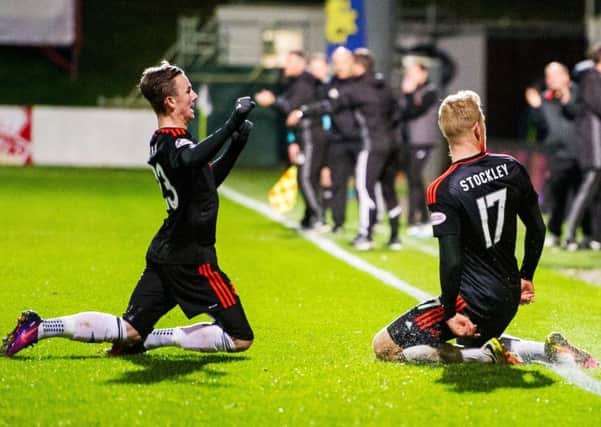Five things we learned from the Scottish football weekend


Aberdeen are no longer over-reliant on crosses
With pace and trickery from the likes of Jonny Hayes, Niall McGinn, we have become accustomed over the past few seasons to Aberdeen scoring many of their goals by getting the ball wide as often as possible then aiming for, more often than not, Adam Rooney.
While these players have been retained, and the trio of Rooney, McGinn and Hayes play most weeks, the addition of James Maddison has brought with it a change in this trend.
Advertisement
Hide AdAdvertisement
Hide AdAnthony O’Connor’s opening goal versus Partick Thistle was just the second time Aberdeen have scored from a cross from open play in the league this season - even then it was from a central position - the other being Jayden Stockley’s goal versus Dundee in September.
Derek McInnes said at the start of the season, then referenced it again in Friday’s pre-match interview, that he signings over the summer were to bring more physicality. While this hasn’t converted into being more dangerous at scoring from set-pieces - discounting Maddison scoring directly against Celtic, they have converted just three set-pieces - they have only conceded from two corners - again, one of these came on Friday night - and the closest they came to conceding from a cross from open play was Tom Rogic’s goal the previous week.
Just like when Maddison delicately slid in Jayden Stockley for his wonder goal, McInnes’ side are much more likely to be cutting teams open. Around half of Aberdeen’s goals in the league this season s have been from keeping the ball on the ground.
Back three is becoming the fashion in the Ladbrokes Premiership
In recent weeks we’ve seen Dundee, Hamilton and Partick Thistle all switch to a back three. They all lined up in that way this weekend and were joined by Brendan Rodgers’ Celtic, who decided to move Mikael Lustig into central defence in order to accommodate both Moussa Dembele and Leigh Griffiths in the side.
Curiously, he opted to drop his two full-backs from their midweek draw with Borussia Monchengladbach, even though the two are suited to move forward slightly and operate as wingbacks. Instead he fielded Patrick Roberts and Scott Sinclair in wide areas, though was forced to abandon this plan midway through the first half because of injury.
The back three was used to great effect by many sides at the last two major international tournaments and with Robbie Neilson, Derek McInnes and Jim McIntyre also all willing to flirt with a back three, it is becoming a more and more popular shape for our domestic game.
Celtic can just put any starting XI out in this league
Relatedly, there has rarely been such a gulf between the champions-elect and the chasing pack. It is so vast that Celtic are able to field just about any eleven players and come away with a result. Hearts’ draw with St Johnstone demonstrates the little between the four or five sides that make up the rest of the top half, but Celtic’s last two wins over Highland opposition is an indicator of how rarely they are going to drop points this season.
Advertisement
Hide AdAdvertisement
Hide AdRodgers made eight changes for the 4-0 win in Dingwall last week and started the victory over Inverness with wingers in the wingback positions. Not only that, Celtic were forced to change to a back four and, even with Stuart Armstrong in an unfamiliar right-back role, comfortably brushed aside a resurgent Inverness side.
Hearts continue to struggle for a strike partnership
Don Cowie may have moved to the top of the league’s assist chart with his corner for Callum Paterson’s late equaliser, and they may have Sam Nicholson on four assist along with a clutch of other Premiership players. They also may have scored 21 league goals, second only to Celtic, but there is little-to-zero contribution coming from the strikers.
This weekend Robbie Neilson decided to try Tony Watt and Bjorn Johnsen as a pairing after the latter’s goal in Inverness the previous week. Sadly, neither got on the scoresheet though Johnsen did play a part in the opening goal when his effort ricocheted off the bar and into the path of Prince Bauben.
It means that Hearts have got four goals from their four strikers over 12 league matches. Combined they have scored the same amount of league goals as Paterson, whose goal earned Neilson’s men a point.
Things look slightly better when considering assists from the strikers. Conor Sammon has three, Robbie Muirhead has two and Johnsen has one. Surprisingly it is Tony Watt who has contributed the least, with one goal and zero assists.
Partick Thistle will be fine
Even when they were beginning to look like permanent fixtures at the bottom of the division, there was always a suspicion that Partick Thistle would eventually climb the table - though most would concede that they will still be involved in a relegation scrap as the season progresses.
Dropping Adam Barton into the middle of Liam Lindsay and Danny Devine may correlate with an upturn in results, but Thistle were never far away in the matches prior to that. They’d drawn four of their five matches before that crucial win over Dundee and have only lost by more than a goal in two of their 12 league matches so far.
And while they have conceded two goals in seven in those matches, they haven’t conceded three or more in a match yet and have only done so once in 17 matches in all competitions.
